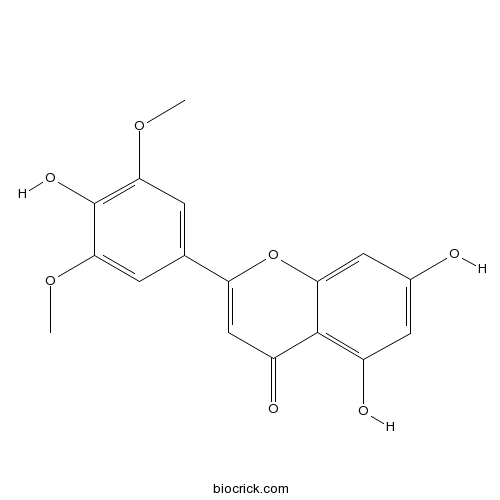The 3',5'-di-O-methyl ether of tricetin. Known commonly as tricin, it is a constituent of rice bran and has been found to potently inhibit colon cancer cell growth.
InChI=1S/C17H14O7/c1-22-14-3-8(4-15(23-2)17(14)21)12-7-11(20)16-10(19)5-9(18)6-13(16)24-12/h3-7,18-19,21H,1-2H3
Tricin, a naturally occurring flavone, has anti-inflammatory potential and exhibits diverse biological activities including antigrowth activity in several human cancer cell lines and cancer chemopreventive effects in the gastrointestinal tract of mice, might be beneficial in HSC-targeting therapeutic or chemopreventive applications for hepatic fibrosis. [1]
Tricin exerts potential role as a chemopreventive and anticancer agent, is a potential multifunctional nutraceutical.[2]
Tricin is fully compatible with lignification reactions, is an authentic lignin monomer, and because it can only start a lignin chain, functions as a nucleation site for lignification in monocots. [3]
Dietary tricin inhibits inflammation-related mouse colon carcinogenesis by suppressing the expression of TNF-alpha in the nonlesional cyrpts and the proliferation of adenocarcinomas suggest a potential use of tricin for clinical trials of colorectal cancer chemoprevention.[4]
Tricin is a type of tyrosinase inhibitor with good efficacy compared to arbutin, functioned as a non-competitive inhibitor of tyrosinase, with an equilibrium constant of 2.30mmol/L. [5]
Tricin is a novel compound with potential COX inhibitor-dependent anti-HCMV activity,can decrease the expression of IE antigen (especially IE2) and cyclooxygenase 2 (COX-2) expression in HCMV-infected cells, completely inhibit prostaglandin E2 (PGE2) accumulation by HCMV infection. [6]
[1] Seki N, Toh U, Kawaguchi K, et al. J Cell Biochem, 2012, 113(7):2346-55.
[2] Zhou J M, Ibrahim R K. Phytochem Rev, 2010, 9(3):413-24.
[3] Seki N, Toh U, Kawaguchi K, et al. J Cell Biochem, 2012, 113(7):2346-55.
[4] Oyama T, Yasui Y, Sugie S, et al. Cancer Prev Res, 2009, 2(12):1031-8.
[5] Mu Y, Li L, Hu S Q. Spectrochim Acta A , 2013, 107C(7):235-240.
[6] Akuzawa K, Yamada R, Li Z, et al. Antiviral Res, 2011, 91(3):296-303.
[7] Zhao P F. Chinese Journal of Pharmaceutical Analysis, 2009,11.



